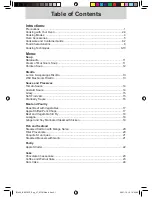
- 8 -
Food Characteristics
FOOD CHARACTERISTICS
AND THEIR EFFECTS ON
MICROWAVE COOKING
Bone and Fat
Both bone and fat affect cooking. Bones
may cause irregular cooking. Meat next
to the tips of bones may be overcooked
while meat positioned under a large
bone, such as a ham bone, may be
undercooked. Large amounts of fat
absorb microwave power and the
meat next to these areas may be
overcooked.
Density
Porous, airy foods such as bread,
cakes or rolls take less time to cook
than heavy, dense foods such as
potatoes and roasts.
Quantity
Two potatoes take longer to cook than
one potato. As the quantity of the food
decreases so does the cooking time.
Overcooking will cause the moisture
content in the food to decrease and a
fi
re could result. Never leave microwave
unattended while in use.
Shape
Uniform sizes heat more evenly. The
thin end of a drumstick will be cooked
more quickly than the meaty end. To
compensate for irregular shapes, place
thin parts toward the centre of the dish
and thick pieces toward the edge.
Size
Small or thin pieces cook more quickly
than thick pieces.
Starting Temperature
Foods that are room temperature take
less time to cook than if they are at
refrigerator temperature or frozen.
IP1430_B8S70CP_Eng_07_071015.indd Sec1:8
IP1430_B8S70CP_Eng_07_071015.indd Sec1:8
2007-10-15 14:02:25
2007-10-15 14:02:25









































